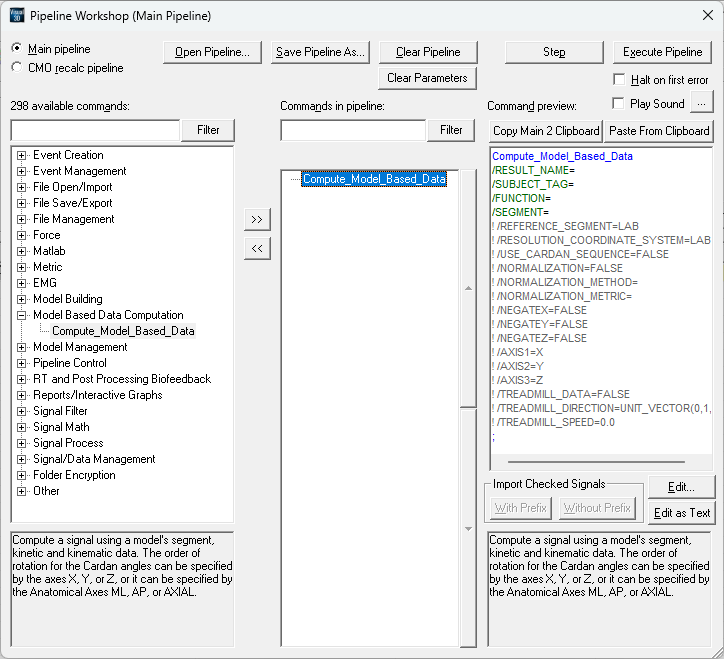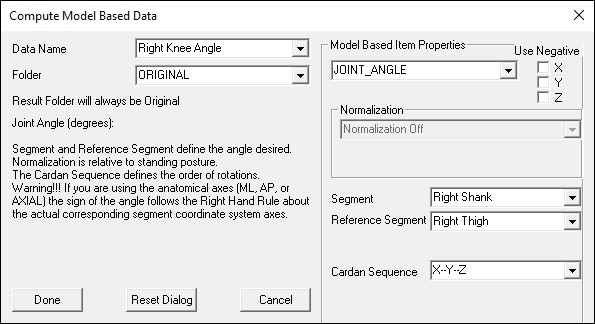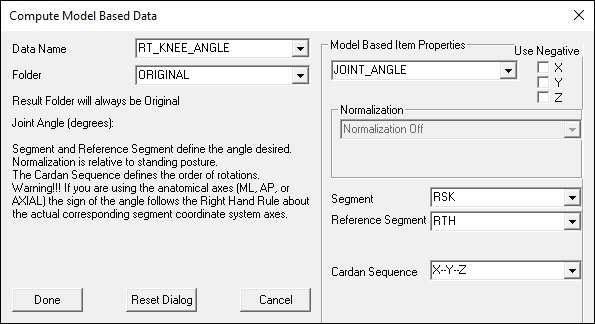Table of Contents
Compute Model Based Data
The Compute_Model_Based_Data command computes a link-model based signal using a model's segments and Kinetic_Kinematic data. This replicates the functionality of the model-based items dialog and can be thought of as encoding a particular model-based item's definition.
Compute_Model_Based_Data /RESULT_NAME= /SUBJECT_TAG= /FUNCTION= /SEGMENT= ! /REFERENCE_SEGMENT=LAB ! /RESOLUTION_COORDINATE_SYSTEM=LAB ! /USE_CARDAN_SEQUENCE=FALSE ! /NORMALIZATION=FALSE ! /NORMALIZATION_METHOD= ! /NORMALIZATION_METRIC= ! /NEGATEX=FALSE ! /NEGATEY=FALSE ! /NEGATEZ=FALSE ! /AXIS1=X ! /AXIS2=Y ! /AXIS3=Z ! /TREADMILL_DATA=FALSE ! /TREADMILL_DIRECTION=UNIT_VECTOR(0,1,0) ! /TREADMILL_SPEED=0.0 ;
Parameters
| Parameter | Description | Default Value |
|---|---|---|
| /RESULT_NAME | The name of the Link_Model_Based item. | |
| /SUBJECT_TAG | The subject tag for the Link_Model_Based item. | The active Subject_Tag in the workspace. |
| /FUNCTION | The "type" of Link_Model_Based item to compute. | |
| /SEGMENT | The Link_Model_Based item's segment in question. | |
| /REFERENCE_SEGMENT | The Link_Model_Based item's reference segment. | The LAB segment. |
| /RESOLUTION_COORDINATE_SYSTEM | The coordinate system into which the Link_Model_Based item is resolved. | The LAB segment. |
| /USE_CARDAN_SEQUENCE | Whether or not to use a Cardan sequence. | FALSE |
| /NORMALIZATION | Whether or not to normalize the Link_Model_Based item. | FALSE |
| /NORMALIZATION_METHOD | Which normalization method, if any, to use. | |
| /NORMALIZATION_METRIC | Which metric, if any, to use as a normalization baseline. | |
| /NEGATEX | Whether or not to negate the Link_Model_Based item's X-component. | FALSE |
| /NEGATEY | Whether or not to negate the Link_Model_Based item's Y-component. | FALSE |
| /NEGATEZ | Whether or not to negate the Link_Model_Based item's Z-component. | FALSE |
| /AXIS1 | The first rotation axis for a Cardan sequence. | X |
| /AXIS2 | The second rotation axis for a Cardan sequence. | Y |
| /AXIS3 | The third rotation axis for a Cardan sequence. | Z |
| /TREADMILL_DATA | Whether or not treadmill data is being used to calculate this Link_Model_Based item. | FALSE |
| /TREADMILL_DIRECTION | If treadmill data is being used, the treadmill's direction of travel. | UNIT_VECTOR(0,1,0) |
| /TREADMILL_SPEED | If treadmill data is being used, the treadmill's speed in m/s. | 0.0 |
If Cardan angles are being used, then the order of rotation can be specified by the axes X, Y, and Z, or it can be specified by the anatomical axes ML, AP, and AXIAL.
Model-based Items and the RECALC Pipeline
This command structure is the same regardless of whether the command is in the Pipeline or RECALC Pipeline. When this signal is created, the definition of the model-based item is stored automatically in the RECALC pipeline.
Note that the command can be executed from the pipeline, but it isn't possible to execute the RECALC pipeline. This is a quirk of the default structure. The RECALC pipeline is executed by selected the RECALC button on the toolbar or executing the Recalc command in the pipeline.
Example: Right Knee Angle
For example, the Right Knee Angle signal could be represented as:
If the text representation of this signal is opened, the following information will be stored
Compute_Model_Based_Data /RESULT_NAME=Right Knee Angle /FUNCTION=JOINT_ANGLE /SEGMENT=RSK /REFERENCE_SEGMENT=RTH /RESOLUTION_COORDINATE_SYSTEM= ! /USE_CARDAN_SEQUENCE=FALSE ! /NORMALIZATION=FALSE ! /NORMALIZATION_METHOD=FALSE ! /NORMALIZATION_METRIC= ! /NEGATEX=FALSE ! /NEGATEY=FALSE ! /NEGATEZ=FALSE ! /AXIS1=X ! /AXIS2=Y ! /AXIS3=Z ;
What is notable is that the segments are identified as RSK and RTH, not Right Shank and Right Thigh as seen in the dialog.
In other words, it appears that the dialog was created as follows:
This is because the lower level representations are stored with the standard Visual3D acronyms (e.g. those names that are used under the covers), whereas the interface to Visual3D uses the names that are mapped by the config files.



